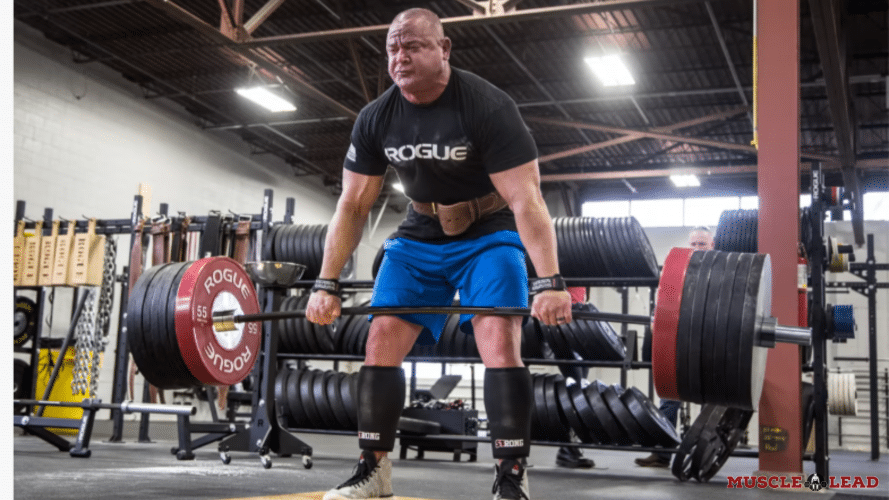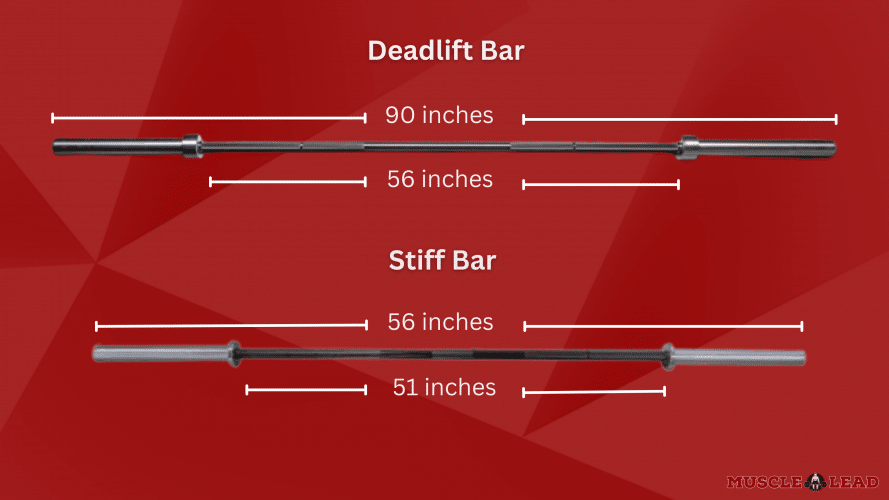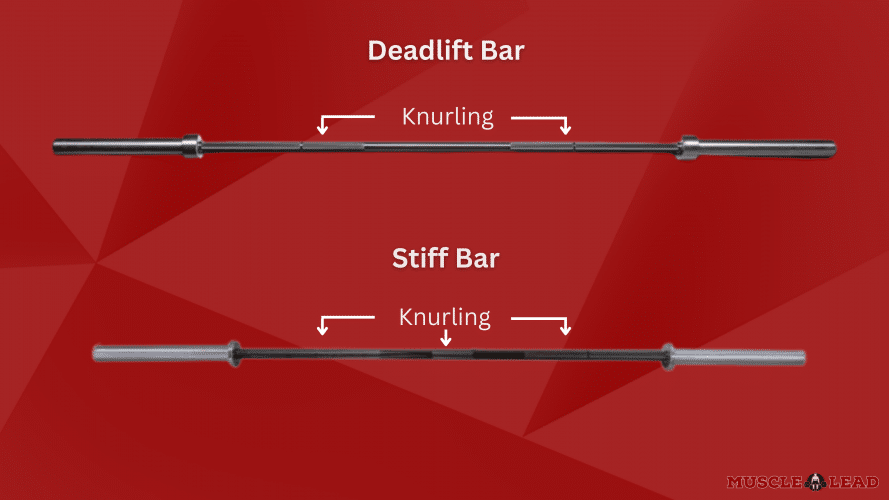Many ‘gym goers’ are not even aware that there are different variants of the barbell. This article we will discuss the deadlift bar vs stiff bar.
On behalf of MuscleLead, I have dedicated this article to highlighting both of these bars.
I have then covered the unique differences in characteristics between the bars, and how these can be advantageous.
Towards the end of the article I have answered some frequently asked questions, to reach more of our audience.
To finalize, I have given my final thoughts to have you set for your barbell based lifts.
Getting to Know the Deadlift Bar vs Stiff Bar
What Is the Deadlift Bar?
The answer is kind of in the name. The deadlift bar is primarily used for the deadlift. As you probably know, lifting a loaded barbell straight off the ground.
Deadlift bars are more accessible in advanced powerlifting gyms. This is where the lifters are actually stacking and ripping some seriously heavy loads.

Without giving away too much, the deadlift bar is thinner, longer and may be more flexible compared to the stiff bar. Moreover, the deadlift bar does not have a center knurling.
Learn more about Deadlifting Barefoot vs. Deadlifting in Lifting Shoes
What Is the Stiff Bar?
On the other hand, the stiff bar is basically the standard 45lb bar that you can find in most commercial fitness gyms.
Or, you can find more advanced powerlifting and weightlifting gyms. Stiff bars are more commonly known as the conventional bar, straight bar, or Olympic bar.
The stiff bar is suitable for a variety of exercises, like the bench press, barbell back row, overhead press.
The Deadlift Bar Vs. the Stiff Bar: The Differences
There are main differences between these two that I have highlighted below.
1. Difference in Bar Length
The shaft of the deadlift bar is around 56”, whereas the stiff bar is 4” shorter at 51”. This difference in length does not seem like much but makes a difference.
Overall the deadlift bar is 4” longer at 90” vs. the 86” Stiff bar. This includes the shaft and sleeves.

In my opinion, this difference in bar mechanics gives some leeway to taller lifters who have longer limbs.
It allows these lifters to apply a nice wide foot position during the sumo style deadlift. Also, it allows them to reap all of the muscle and strength benefits of the deadlift variation.
2. Difference in Sleeve Lip
The sleeve lip is the thickest part of a barbell, large enough in circumference to stop the weight plates from shifting over to the shaft (1).
Clearly, the sleeve lip is wider on the deadlift bar, contributing towards the wide sumo stance that I mentioned in the previous ‘difference in bar length’ point.
3. Difference in Tensility
The deadlift bar may be more flexible. But, compared to the stiff bar it does not have the capacity to hold more loads before reaching breaking point.
I am not just saying this, the pound-force per square inch has actually been documented in the specifications.
That being said, the stiff bar has its place for safe and effective pushing based lifts like the barbell squat.
4. Difference in Sleeve Length
The bar sleeve is where the bar is loaded. So, it would make sense why the deadlift bar is 2” shorter to stack less weight plates owing to its tensile strength right?
On average, the deadlift bar sleeves are around 15” in length and the stiff bar sleeves are around 17”.
5. Difference in Bar Circumference
The Deadlift bar is thinner from the shaft and sleeves by a couple of inches. This may seem miniscule, but it makes all the difference during either the deadlift or pressing movements.
A thinner bar may be easier to grip and have more flexibility while holding heavier loads. Overall, giving a lifter the best chance of hitting those strived for personal records.
The thicker stiff bar may have some advantages during pressing movements, as the shaft does not cause as much pain on the flesh of the hands like the deadlift bar.
I recall a time when the gym was so busy on a ‘chest monday’, the only available bar was the deadlift variant.
Being a relatively new lifter at the time, I decided to use the deadlift bar for the bench press without knowing the difference.
I kid you not, it felt as if the shaft was going to rip through my hands, leaving some bar marks.
Read more about Experiencing Shoulder Pain from Deadlifting
6. Difference in Flexibility
The deadlift bar is more flexible under heavy loads, making the lift more efficient with full range of motion (1).
For this reason, I would highly recommend getting used to deadlifting with the deadlift bar.
This recommendation may not be as important to many of you right now. However, I expect you to become better deadlifters as the years pass, possibly reaching that ‘powerlifter’ status.
This is where you will look back and appreciate the knowledge and recommendations that you picked up at musclelead.com.
Even if your goal is not to become a competitive powerlifter and you merely just want to get a little stronger, the benefit from the deadlift bar still outweighs the stiff bar for the deadlift.
However, you could still pass with a stiff bar if it is the only bar available at your gym. It is probably not worth going out of your way to purchase the bar and specific plates.
7. Difference in Centre Knurling
The difference here is quite simple, the stiff bar has a knurling and the deadlift bar does not.
The center knurling is thought to offer some friction for the bar to stabilize the bar on certain areas of the body.
For example, during the clean and jerk, a weightlifter needs to catch the bar on the chest/shoulders to perform the second part of the lift.

More specific to ‘gym goer’, the stiff bar knurling sits on the upper back/shoulder before performing a barbell squat.
But How Does This Make a Difference to the Deadlift?
During the deadlifting, this may be disadvantageous from the knurling rubbing against any part of the body, thus halting the pathway and making the lift less efficient.
Just look at how the center knurling the stiff bar creates friction (1) around the crotch area. Then, compare it to how smooth the lift with the deadlift bar was.
So for this reason, you might agree that the deadlift bar being knurling less is advantageous only for the deadlift.
Frequently Asked Questions
Although the bars have different metrics in terms of length and circumference, both bars are around the same weight of 45 lbs/20kg.
You can certainly load up more weight on the stiff bar from its tensility. By no means does this mean that it’s the best bar to produce an efficient deadlift.
The answer is in the question, the stiff bar deadlift uses the stiff Olympic barbell.
It may be harder owing to the fact that the shaft circumference is larger, so it is more difficult to grip. Furthermore, the knurling of the stiff bar could potentially come into contact with any part of the body and create some friction stopping halting the deadlift pathway.
Final Thoughts
The shaft of the deadlift bar is longer and the sleeve lip is located wider compared to the stiff bar, giving it an advantage for the sumo stance deadlift, especially for lifters with longer limbs.
The stiff bar is stronger with longer sleeves, giving it more loading capacity.
Nevertheless, the deadlift bar presents a thinner and more flexible shaft, making it easier to grip and complete a more efficient deadlift.
The deadlift bar does not have a center knurling unlike the stiff bar, giving lifters a better chance of a more efficient bar pathway, without getting halted by the knurling.
To wrap this up, the deadlift bar may be the best bar for the deadlift, but not great for other lifts.
Read More
- Trap Bar Deadlift Vs Front Squat: How To, Pros, Cons
- 20 Best Exercises To Improve Deadlift Strength
- Upper Back Pain While Deadlifting (5 Reasons And How To Fix)
- 8 Best Deadlift Accessory Exercises To Increase Strength
- Good Mornings vs. Deadlifts: 9 Important Factors Compared
- How Do Deadlifts Change Your Body? 9 Ways Before & After





